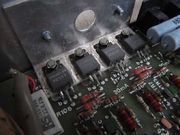Audio equipment
This page covers audio equipment, in particular radios, Hi-Fi systems and portable CD and cassette players, and what you can hope to achieve.
Summary
Audio equipment can quite often be repaired. In the case of a multi-function item such as a music centre, the first step is to determine which functions still work and which don't. The sections handling the most power are most likely to fail. Blown transistors in the audio power output and electrolytic capacitors in the power supply are relatively easily replaced.
Mechanical problems can be trickier. Replacements are available for perished rubber belts but they can be hard to fit in the case of a cassette player. Record decks are simpler, though the workings of an autochanger can be hard to understand.
A separate page covers CD and DVD players.
Safety
- Operating mains powered equipment with the covers off may be highly dangerous. You should not attempt it unless you are completely competent to understand and manage the risks, both to yourself and any bystanders.
- Audio amplifiers of even modest power output ratings can operate with quite high voltages internally, often in the range of 50 - 100V. Though not as dangerous as the mains, such voltages need nevertheless to be treated with respect.
- Valve radios and amplifiers are not common, but if you have to deal with one remember that it will contain high voltages which may be just as dangerous as the mains. Remember also that smoothing capacitors may retain enough charge to give you a nasty shock even after the mains has been disconnected.
Amplifiers
Problems with amplifiers most commonly appear in those parts handling the most power, that is the mains power supply and the power output stage.
Power supplies are covered in their own page. Look out in particular for bulging electrolytic capacitors, especially if there is excessive hum from the loudspeakers. Bear in mind though that overheating components or a fuse which repeatedly blows may be a symptom of a problem elsewhere.
The power output stage often consists of two or two pairs of transistors connected in series between the positive and negative supplies. There will be one set for the left and one for the right in a stereo amplifier. These may be either bipolar or field-effect types. Bipolar transistors can be subject to thermal runaway: overheating causes an increase in the current drawn, which in turn causes the overheating to get worse, and so on until the transistor fails. This often results in an effective short circuit between the positive and negative supplies, causing a fuse to blow, sometimes spectacularly.
You should remove the transistors for testing and replace them as a pair. They will often have different numbers and it's essential to fit the right one in the right place. Take care to ensure good thermal contact with the heat sink, cleaning off and replacing heatsink paste if used, and not loosing an insulating washer if fitted.
Tuners and radios
First of all, check whether there is any possibility that the batteries (if used) have at any time been installed the wrong way round. If so, there is a strong possibility that this would have done irreparable damage.
Corrosion of the contacts in the battery compartment is common, caused by leaking chemicals from dead batteries which have been left in the device. Clean the contacts with switch cleaning fluid or isopropyl alcohol on a tissue or cloth.
Switches and push-buttons can also be troublesome. They are covered in their own page.
Modern equipment often uses a digital volume control activated through push-buttons or a rotary encoder, but formerly a potentiometer was universally used. This can cause loud crackles from the loudspeakers when it gets old or worn. Remediation is covered in the section on potentiometers.
Tuners often contain adjustable trimmer capacitors or coils with adjustable ferrite cores. These are set up and sealed in the factory. Never try "tweaking" them as their proper adjustment requires laboratory equipment such as a signal generator and oscilloscope, without which it would be almost impossible to do anything but make things worse.
DAB radios ought to be very reliable as they have few mechanical parts, but nevertheless failures are not uncommon. Firstly, look for broken wires or connections and signs of poor workmanship such as bad solder joints. A faulty power supply is another possibility. Check whether the device works on batteries but not on mains. If it uses a separate power adapter, test its output voltage with a multimeter. If it runs directly off the mains then it will have an internal power supply. In this case, extreme caution must be observed if any tests are carried out with the device open. Only do so if you are completely confident that you can do so safely. Whether the unit runs on mains or batteries, it may well have internal circuitry to provide different voltages for the analogue and digital sections. You may be able to identify this and test it with a multimeter.
Record Players and Cassette Decks
Problems with these are most often mechanical, in particular, worn or perished belts or dirt build up, possibly in bearings. A careful visual inspection whilst trying to operate the part in question may show what is wrong.
Replacement belts are available from online sources. The mechanisms tend to be quite intricate so the degree of disassembly required may range from a simple job if the replacement belt can be simply looped over its pulleys, to a complex one requiring care and patience if the pulleys are less accessible.
Intro to Cassette Recorder Operation, Maintenance, and Repair at Instructables.com gives an excellent introduction to fixing cassette decks of various sorts.
External links
Consult Home Stereo and Theatre at:
iFixit
Consult Audio and Video Equipment at:
Repair Café
